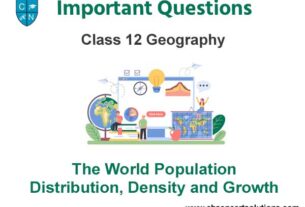Students can read the important questions given below for Planning and Sustainable Development in Indian Context Class 12 Geography. All Planning and Sustainable Development in Indian Context Class 12 Notes and questions with solutions have been prepared based on the latest syllabus and examination guidelines issued by CBSE, NCERT and KVS. You should read all notes provided by us and Class 12 Geography Important Questions provided for all chapters to get better marks in examinations. Geography Question Bank Class 12 is available on our website for free download in PDF.
Important Questions of Planning and Sustainable Development in Indian Context Class 12
I. Read the case study given below and answer the questions that follow:
Drought Prone Area Programme was initiated during the Fourth Five Year Plan with the objectives of providing employment to the people in drought-prone areas and creating productive assets. Initially, this programme laid emphasis on the construction of labour-intensive civil works.But later on, it emphasised on irrigation projects, land development programmes, afforestation,grassland development and creation of basic rural infrastructure, such as electricity, roads, market, credit and services.
The National Committee on Development of Backward Areas reviewed the performance of this programme. It has been observed that this programme is largely confined to the development of agriculture and allied sectors with major focus on restoration of ecological balance. Since growing population pressure is forcing the society to utilise the marginal lands for agriculture, and, thereby causing ecological degradation, there is a need to create alternative employment opportunities in the drought-prone areas. The other strategies of development of these areas include adoption of integrated watershed development approach at the micro-level. The restoration of ecological balance between water, soil, plants, and human and animal population should be a basic consideration in the strategy of development of drought-prone areas.
Question. When was the Drought Prone Area Programme initiated?
(A) Fourth Five Year Plan
(B) Fifth Five Year Plan
(C) Sixth Five Year Plan
(D) Seventh Five Year Plan
Answer
A
Question. What was its objective?
(A) Providing employment to the people in drought-prone areas
(B) Creation of basic rural infrastructure
(C) Afforestation
(D) All of the above
Answer
D
Question. Who reviewed the performance of the DPAP?
(A) National Committee on Development of Backward Areas
(B) National Commission on Development of Backward Areas
(C) National Compartment on Development of Backward Areas
(D) None of the Above
Answer
A
Question. Which state has a low literacy rate?
(A) Integrated watershed development approach
(B) Integrated waterfall development approach
(C) Intelligent watershed development approach
(D) Integrated watershed department approach
Answer
A
II. Read the case study given below and answer the questions that follow:
Bharmaur tribal area comprises Bharmaur and Holi tehsils of Chamba district of Himachal Pradesh. It is a notified tribal area since 21 November 1975. Bharmaur is inhabited by ‘Gaddi’, a tribal community who have maintained a distinct identity in the Himalayan region as they practised transhumance and conversed through Gaddiali dialect.
Bharmaur tribal region has harsh climate conditions, low resource base and fragile environment. These factors have influenced the society and economy of the region. According to the 2011 census, the total population of Bharmaur sub-division was 39,113 i.e., 21 persons per sq km. It is one of the most(economically and socially) backward areas of Himachal Pradesh. Historically, the Gaddis have experienced geographical and political isolation and socio- economic deprivation. The economy is largely based on agriculture and allied activities such as sheep and goat rearing. The process of development of tribal area of Bharmaur started in 1970s when Gaddis were included among ‘scheduled tribes’.
Question. In which year was Bharmaur notified as a tribal area?
(A) 1965
(B) 1975
(C) 1985
(D) 1995
Answer
B
Question. What was the population of Bharmaur according to the 2011 Census?
(A) 39,113
(B) 29,113
(C) 49,113
(D) 59,113
Answer
A
Question. Bharmaur is the most economically backward area of __________.
(A) Uttarakhand
(B) Himachal Pradesh
(C) Jammu & Kashmir
(D) Ladakh
Answer
B
Question. The process of development of tribal area of Bharmaur started in _________ when Gaddis were included among ‘scheduled tribes’.
(A) 1950s
(B) 1960s
(C) 1970s
(D) 1980s
Answer
C
III. Read the case study given below and answer the questions that follow:
Indira Gandhi Canal, previously known as the Rajasthan Canal, is one of the largest canal systems in India. Conceived by Kanwar Sain in 1948, the canal project was launched on 31 March, 1958.The canal originates at Harikebar rage in Punjab and runs parallel to Pakistan border at an average distance of 40 km in Thar Desert (Marusthali) of Rajasthan. The total planned length of the system is 9,060 km catering to the irrigation needs of a total culturable command area of 19.63 lakh hectares.Out of the total command area, about 70 per cent was envisaged to be irrigated by flow system and the rest by lift system. The construction work of the canal system has been carried out through two stages. The command area of Stage-I lies in Ganganagar, Hanumangarh and northern part of Bikaner districts. It has a gently undulating topography and its culturable command area is 5.53 lakh hectares. The command area of Stage-II is spread over Bikaner, Jaisalmer, Barmer, Jodhpur,Nagaur and Churu districts covering culturable command area of 14.10 lakh ha. It comprises desert land dotted with shifting sand dunes and temperature soaring to 50°C in summers. In the lift canal, the water is lifted up to make it to flow against the slope of the land. All the lift canals of
Indira Gandhi Canal system originate at the left bank of main canal while all the canals on the right bank of main canal are flow channels.
Question. When was the Indira Gandhi Canal Project launched?
(A) 1948
(B) 1958
(C) 1968
(D) 1978
Answer
B
Question. The canal caters to the irrigation needs of a total culturable command area of ________lakh hectares.
(A) 19.63
(B) 19.83
(C) 19.73
(D) 19.93
Answer
A
Question. The command area of ______is spread over Bikaner,Jaisalmer, Barmer, Jodhpur, Nagaur and Churu districts.
(A) Stage I
(B) Stage II
(C) Stage III
(D) Stage IV
Answer
B
Question. In ____________ water is not transported by natural flow, but is lifted with pumps or surge pools.
(A) Lift canal
(B) Shift canal
(C) Substitute canal
(D) None of the Above
Answer
A
Read the case/source given and answer the following questions.
The processes of human-environment interaction depend upon the level of technology and institutions nurtured by a society. While the technology and institutions have helped in increasing the pace of human-environment interaction, the momentum thus, generated in return has accelerated technological progress and transformation and creation of institutions.
Hence, development is a multi-dimensional concept and signifies the positive, irreversible transformation of the economy, society and environment. The concept of development is dynamic and has evolved during the second half of twentieth century.
In the post World War II era, the concept of development was synonymous to economic growth which is measured in terms of temporal increase in Gross National Product (GNP) and per capita income/per capita consumption. But, even the countries having high economic growth, experienced speedy rise in poverty because of its unequal distribution. So, in 1970s, the phrases such as redistribution with growth and growth and equity were incorporated in the definition of development.While dealing with the questions related to redistribution and equity, it was realised that the concept of development cannot be restricted to the economic sphere alone. It also includes the issues such as improving the well-being and living standard of people, availing of the health, education and equality of opportunity and ensuring political and civil rights. By 1980s, development emerged as a concept encapsulating widespread improvement in social as well as material well-being of all in a society. The notion of sustainable development emerged in the wake of general ,rise in the awareness of environmental issues in the late 1960s in Western World. It reflected the concern of people about undesirable effects of industrial development on the environment. The publication of ‘The Population Bomb’ by Ehrlich in 1968 and ‘The Limits to Growth’ by Meadows and others in 1972 further raised the level of fear among environmentalists in particular and people in general. This sets the scenario for the emergence of new models of development under a broad phrase ‘sustainable development.’
Question. What bases are needed for the human-environment interaction?
Answer. The bases which are needed for the human-environment interaction are level of technology and institutions nurtured by a society.
Question. Explain in brief about the notion of development during the post Second World War.
Answer. In the post Second World War era, the concept of development was related to economic growth that is measured as increase in Gross National Product (GNP) and per capita income/consumption over a period of time. But even the countries having high economic growth experienced rapid rise in poverty because of its unequal distribution. So, in the 1970s, development started including equity and redistribution along with growth.
Question. Which major event was responsible for the origin of the concept of sustainable development in the western world?
Answer. The major event responsibe for the origin of the concept of sustainable development in the western world was the general rise in the awareness of environmental issues in the late 1960s in the Western world. It reflected the concerns of people about the undesirable effects of industrial development on environment.
Read the case/source given and answer the following questions.
There is no uniform economic development over space in any country. Some areas are more developed and some lag behind. This uneven pattern of development over space necessitates that the planners have a spatial perspective and draw the plans to reduce regional imbalance in development.This type of planning is termed as regional planning.
The planning process has to take special care of those areas which have remained economically backward. As you know, the economic development of a region
depends upon its resource base. But sometimes resource-rich region also remain backward.
Economic development requires technology, as well as, investment besides resources. With the planning experience of about one-and-a-half decades, it was realised that regional imbalances in economic development were getting accentuated.
In order to arrest the accentuation of regional and social disparities, the Planning Commission introduced the ‘target area’ and target group approaches to planning. Some of the examples of programmes directed towards the development of target areas are Command Area Development Programme, Drought Prone Area Development Programme, Desert Development Programme, Hill Area Development Programme.
The Small Farmers Development Agency (SFDA) and Marginal Farmers Development Agency (MFDA) which are the examples of target group programme.In the 8th Five Year Plan special area programmes were designed to develop infrastructure in hill areas,North-Eastern states, tribal areas and backward areas.
Question. Which aim signifies the term regional planning?
Answer. The main aim of regional planning which signifies it, is to reduce imbalances in development which is found over space in any country.
Question. Which approaches were introduced by the planning commission in order to reduce the regional and social disparities in India? Give examples.
Answer. In order to reduce the regional and social disparities, the Planning Commission introduced the ‘target areas’ and ‘target group’ approaches to planning.
Examples of target area programmes are Command Area Development Programme, Drought Prone Area Development Programme, Desert Development Programme and Hill Area Development Programme.
Examples of target group programmes are Small Farmers Development Agency (SFDA) and Marginal Farmers Development Agency (MFDA).
Question. What does economic development requires besides resources? Why their is to reduce imbalances in economic development?
Answer. Economic development requires technology, as well as, investment besides resources. There is a great need to reduced imbalances in economic development because by the planning experience of about one-and-a-half decades, it was realised that regional imbalances in economic development were getting prominent.


